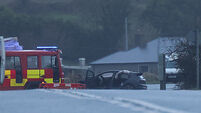Air controller had back turned when jet went down wrong runway
The lone US air traffic controller on duty the morning Comair Flight 5191 crashed had cleared the jet for takeoff, then turned his back to do some “administrative duties” as the aircraft veered down the wrong runway, a federal investigator said in Kentucky.
Separately, the Federal Aviation Administration today acknowledged violating its own policies when it assigned only one controller to the Lexington tower.














